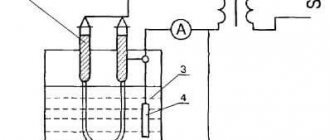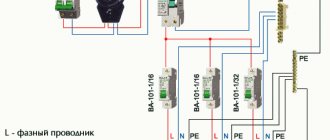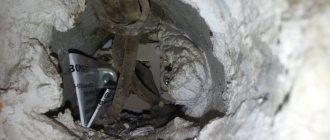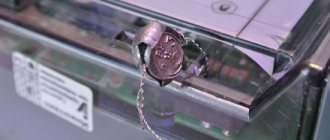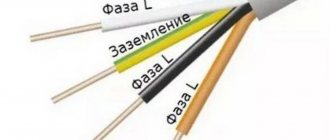Electricity meters have been used for more than a century. Modern meter manufacturers offer devices of various types and modifications. The choice of the optimal electric meter depends on the operating conditions. Based on the operating principle, a distinction is made between electromechanical and electronic meters. Based on the number of phases, electric meters are divided into single-phase and three-phase. Depending on the ability to count at different tariffs, single-tariff and multi-tariff meters are produced.
Each electric meter model has a set of characteristics, including service life. Let's take a closer look at what the concept of “lifetime of a metering device” means and how it differs from similar concepts associated with replacing this equipment.
Basic requirements for metering devices
The legislator does not indicate which electricity meters should be installed at a particular facility. The consumer decides which device to choose independently, depending on the characteristics of the objects, the power of the network and other factors. All electric meters, regardless of type, model, modification, service life, are subject to the following requirements:
- mandatory certification, otherwise operation of the electric meter is prohibited;
- mandatory registration with the company supplying electricity;
- presence of verification seal and seal of the organization supplying electricity;
- the electricity meter number must match the number indicated in the device acceptance certificate;
- installation in a dry place at a height of 1.7 meters. The meter can be wall mounted or placed in an electrical cabinet. In any case, free access to the meter must be ensured;
- connecting the electric meter only with a solid wire. If wire transfer is required, it can be cut and extended, but the connection sections are connected through a special machine and sealed.
Possible ways to lay the wire
Replacing old wiring in a panel house begins with drawing up a new diagram. Also, replacing electrical wiring is divided into two options: partial or complete.
If it is necessary to completely replace all cables in a panel house, then a new circuit should be made. To do everything correctly, a specialist will need an old circuit. The new diagram will serve as step-by-step instructions for performing electrical installation work.
First you need to determine where the load will be. For example, the kitchen typically consumes the most electricity. If we talk about an ordinary room, then one or two sockets per 5 square meters is enough. Considering the needs of the kitchen, the same room will need four sockets. Also, we should not forget that for devices with high electricity consumption it is necessary to draw separate lines from the switchboard. Some household appliances require a copper cable with a cross-section of up to 4-6 squares.
Another room that requires special attention is the bathroom, because it is characterized by high humidity. Therefore, sockets in the bathroom should be connected through a differential circuit breaker or RCD
According to the PUE chapter 7.1. clause 7.1.48 its operation current should not be more than 30 mA. Also, an RCD must be installed to protect individual electrical appliances that are the most dangerous from the point of view of electric shock - a washing machine, a water heater, a hydromassage box, a hydromassage bathtub. In the kitchen there is a dishwasher and an electric oven.
When replacing electrical wiring in a panel house, several methods of laying a new cable are used:
- in ceiling slabs;
- under the ceiling covering;
- on the walls - under plaster, under drywall;
- on the floor in a screed.
The most common method of laying cables is to lay the cable under plaster. In order to carry out installation, holes must be made into which the cable will be laid and secured. After installation, a layer of plaster is applied over the cables. Using this method, you can stretch several lines in one groove. You can also lay cables separately for lighting, various appliances, air conditioners, and other heating devices.
It is ideal to lay cables along old channels, because then you can lay the wires without gating and save time. Therefore, it is advisable to use the paths along which old cables were laid. You can mainly use places where aluminum cables have simply been plastered, for example in the joints between the wall and the ceiling. Seams are places where it is easy to install new wiring.
When replacing old cables, you should remember that the channels in which they were located can be used to bring a new copper cable to an outlet or switch. However, the channel can only be used if the fittings are in the same places and if the old cable can be pulled out during dismantling.
In most cases, it is very difficult to find and use channels, so some experts recommend not wasting time on long searches and cleaning channels. Therefore, for horizontal installation in a panel house, it would be more expedient to stretch the cable along the upper joint between the wall and the ceiling. In this place there is usually a gap that is either plastered or filled with cotton wool.
An alternative option is to run electrical wiring along the ceiling and make grooves only in places leading to sockets and switches. You can hide the cable attached to the top by making a suspended or suspended ceiling.
When replacing electrical wiring in a panel house, you must first determine whether the replacement will be partial or complete. It is also necessary to use old channels. In order to carry out this work you need to have a good tool. However, it is preferable that the replacement of electrics in a panel house is carried out by a specialist.
Important! Remember that it is impossible to make horizontal grooves in the load-bearing walls of panel houses. This could cause the wall to collapse
This is also prohibited by various regulatory documents, for example, Decree of the Moscow Government of February 8, 2005 N 73-PP “On the procedure for the reconstruction of premises in residential buildings on the territory of the city of Moscow.” and Government Decree No. 508 (Clause 11.3 and 11.11 Appendix No. 1).
When equipment replacement is required
The service life of the metering device is indicated by the manufacturer. If the meter is operated in accordance with established standards, its service life has not expired, and verifications are carried out in accordance with the schedule, then replacement is not necessary. However, there are a number of cases when it is necessary to dismantle an existing device and install a new meter:
- changing the requirements of the electricity network, carrying out technical work related to updating the network;
- inaccurate readings, malfunctions of the electric meter;
- the presence of damage - cracks, chips and other mechanical damage to the case, failure of the display. A breakdown can be detected both by the consumer himself and by representatives of the management company or organization supplying electricity;
- violation of the integrity of the seal;
- expiration of the device's validity period specified by the manufacturer. Further use of the equipment is considered inappropriate, since no one guarantees the reliability of its operation;
- the meter does not comply with state standards adopted in 2012. According to the new requirements, household electricity meters must comply with an accuracy class of at least 2.0. Industrial electricity meters with a power of up to 670 kW must have an accuracy class of at least 1.0. Electricity meters with a power above 670 kW must be assigned an accuracy class of at least 0.5.
Main concepts
Regardless of the service life of the meter, its consumption is calculated in kilowatt-hours (kWh). Devices are designed for a specific voltage level and electric current.
The equipment is created on the basis of GOST. The maximum clock error of electronic multi-tariff meters is 7.5 minutes.
Popular meter models in Russia
In our country, meters according to the St. Petersburg law “LEMZ” are popular.
- Single-phase induction meter “disk” with accuracy class 2.0. The device operates with electricity at 220 V and a frequency of 50 Hz. The inter-inspection interval is 16 years, and the service period is 32 years. The equipment is considered one of the best, since its functioning is practically flawless.
- Multi-tariff electronic single-phase meter with an accuracy of 1.0. The device measures electricity in a network with 220 V and a frequency of 50 Hz. Thanks to the multi-tariff nature, a specific tariff schedule is established. Operates according to an internal clock. A charging schedule may be set for certain days. The multi-tariff device has a function for independent switching between summer and winter time, although this is not required today. The meter stores information on storage equipment for about 20 years, if there is no mains voltage. The information is located on a special indicator. The service period is 30 years.
- Inexpensive domestic electromechanical single-phase induction devices with an accuracy of 2.0 and 1.0. When purchasing electromechanical induction equipment, you should pay attention to glass (plastic). There should be no debris or dust there, otherwise the device is not made according to the rules.
You should also clarify about the warranty period what will be required in the event of a malfunction or inoperability of the product. The seals on the device must be intact and undamaged. There should be no cracks or scratches on the body.
The equipment usually has a serial number, which should be compared with that indicated in the passport. Blue seals must be present. The kit includes a receipt and a warranty card.
Taking readings from 5-digit equipment
When checking the device, those numbers that start from zero are written off, for example, 09508. In some houses, employees check the meter readings themselves. If this is not the case, then consumers themselves call by phone, dictate their personal account and the necessary numbers.
The difference between the operating period and the warranty and inter-verification periods
In addition to the service life of the metering device, verification periods are established, as well as a warranty period. All specified intervals are determined by the meter manufacturers. The inter-verification period and service life are indicated in the technical passport, and the warranty period is indicated in the warranty card. When choosing an electric meter for an apartment, office or other facility, you should carefully read the technical documentation.
The inter-verification period is a set time interval after which the electricity meter is subject to mandatory control verification. It can vary from 4 to 16 years, depending on the type and model of equipment.
Verification
- this is a procedure that is carried out by specially authorized services in order to monitor the correct operation of the metering device. It can take place both in laboratory conditions and directly on site, without dismantling the equipment. The consumer needs to ensure compliance with the inter-verification period. If the deadlines are missed, the equipment is considered non-functional. Its readings are not taken into account; consumption is calculated based on average electricity use.
In addition to periodic verification, an extraordinary verification is possible - if the technical documentation for the device is lost or the readings do not correspond to the actual flow rate.
The warranty period is the time period during which the manufacturer can replace or repair the equipment free of charge if it malfunctions. Usually it is significantly less than the operating period of the electrical energy meter.
Procedure for checking an electric meter
Electricity meters are checked to assess serviceability and identify signs of external influence.
Electricity consumption metering devices are checked by specialists specially authorized by the relevant organizations. The devices are verified for errors when recording readings:
- at the time of production - primary;
- at the end of the inter-check intervals, the data of the electric meter and control devices are compared - periodic;
- in case of emergency situations (loss or breakage of a seal, loss of the technical passport of the device, doubts about the correctness of the readings, etc.) - extraordinary.
Companies whose employees have the right to inspection and sealing are classified as energy sales or metrology companies. It can be difficult to decide on the latter - find out the organization responsible for the site, contact, negotiate. However, the services of such companies are usually cheaper than a full-time electrician.
The process does not require dismantling the equipment; verification is carried out at the location of the device. Employees carry out work using special measuring devices - an ohmmeter, a wattmeter, which are alternately connected to the meter contacts in several modes. In addition to the correctness of the readings given, the sensitivity of the terminals, the serviceability of the housing and the examination of the appearance of the product are checked.
If, based on the results of the test, it turns out that the current device gives readings with an error, it is recommended to replace the electric meter with a new one. Repairing such equipment is expensive, and faulty technicians do not seal it.
Period of operation of the metering device
The period of operation of an electrical energy meter is an approximate time interval during which (subject to compliance with operating requirements) it should operate without failures. Modern electricity meters last for several decades - on average from 25 to 30 years, depending on the model. At the time of purchase, you must check with the seller what the service life of the electric meter is and what the conditions for using the device are. For example, single-phase, single-tariff and multi-tariff devices of the Pulsar brand produced by NPP TEPLOVODOKHRAN LLC serve for 32 years. In this case, the verification interval is 16 years. Such a long period of operation is due to the absence of moving parts and mechanisms in the design.
The meter may fail before the end of the operating period specified by the manufacturer. As a rule, the decision on further use of the device is made by the authorized body based on the results of verification.
Is it worth giving up?
According to legal regulations, electricity meters are placed outside only with the consent of the owner. The basis for submission to the SNT may be a collective decision made at a general meeting.
Initially, many may perceive such an innovation critically, fearing for the safety of their property. But you also need to take into account the benefits that a change in the location of the device will provide. The controller will no longer bother you with monthly visits.
The indicator data will be sent to the settlement center on time, this eliminates the accrual of penalties and fines, and the occurrence of any misunderstandings. The device is reliably protected by a special shield against hacking and theft. For SNT members, such placement of the meter can also have significant advantages.
Who should change the meter?
Who changes the electricity meter at a specific site? The owner of the facility where the device is located must organize the replacement of the device after its service life or for other reasons:
- inside the apartment (office, store) - the owner of the premises;
- in a common area (for example, a staircase) - a homeowners association, management company or other owner of the property;
- electricity supply organization - if this condition is expressly stated in the service agreement.
How to replace
Each company has certain equipment requirements. However, they do not contradict the laws and regulations established at the state level.
You should first familiarize yourself with the agreement concluded with the electricity supplier. In addition, certain models of specific manufacturers of measuring instruments may be offered by a company representative. In such cases, it is necessary to independently verify the cost of the proposed meter and the market price. And after that decide where it is more profitable to purchase it.
When the initiator of replacing an old induction device is the electricity supplier, then the purchase (installation) costs will also be his. Relocation of the device at the request of the apartment owner is paid separately. You will also need to replace the incoming (power) cable. It must be purchased in advance.
Please note: when the meter is provided free of charge by the company, it must be replaced by a representative, not an outside electrician.
Replacement procedure
The procedure for replacing electricity meters consists of several stages.
- First of all, you need to purchase new equipment of the appropriate accuracy class. Specify the date of manufacture and the date of initial (factory) verification. No more than a year should pass from the date of release until the installation of the device. The equipment must be certified for sale on the domestic market. Please also pay attention to the following nuances:
- all elements must be new, without signs of wear and mechanical damage;
numbers must be set to zero;
- logos of the manufacturer and Rostest should be placed on the control panel;
- there must be verification seals with the abbreviation of the manufacturer;
- the seller must provide a certificate, technical passport, operating instructions, and other accompanying documents.
- The next stage is dismantling the old device.
In this case, the old one must be saved to verify the readings. You can dismantle the counter yourself. However, it is necessary to invite a representative of the energy supplier to remove the seal. Next comes the installation and configuration of the new device. It can be carried out by certified organizations, private electricians who have the appropriate clearance group and individual entrepreneur certificate, representatives of the management company or energy sales. The installation can be carried out yourself if you have the appropriate skills and carry out the installation work taking into account current requirements. - The final stage is putting the device into operation. It is performed by the organization that supplies electricity. A company representative checks the serviceability of the equipment and correct installation, seals the device, and draws up a replacement certificate. The owner of the device must carefully check the device numbers and readings indicated in the report. If agreed, the document is signed by the owner of the equipment and the energy sales representative.
Purpose
Three-phase static electric energy meters “Mercury 230”, “Mercury 230” (hereinafter referred to as meters) are designed for single- and multi-tariff measurements of active and reactive electric energy in forward and reverse directions, active, reactive and apparent electric power, power factors, frequency, voltage and alternating current strength, as well as for measuring electrical energy quality parameters (hereinafter referred to as PQE) in three- and four-wire three-phase AC electrical networks with a frequency of 50 Hz.
Who pays for the replacement?
Replacing a meter is a paid procedure. Financial obligations fall on the following persons:
- if the device is located indoors - to the owner of this premises;
- if the device is placed on a staircase or in other common areas - to the management company (HOA). Payment is made from funds received to the company’s account from the residents of the apartment building;
- if the house is municipal property - to the local authorities (payment is made from budgetary funds);
- when concluding an agreement with an energy company - for this organization.
The validity period of the metering device declared by the manufacturer is a conditional period of its proper operation. The duration of operation is influenced by many factors: the power and intensity of operation of electrical appliances, external conditions (temperature, humidity) and others. Monitoring the operation of equipment and timely replacement is the key to proper control of electrical energy consumption and the absence of problems in the event of periodic and unscheduled inspections by energy supervision authorities.
How to assemble an electrical panel?
It is usually enough for the owner of a house or apartment to contact the energy supply company so that specialists can come and do everything - from the design to the sealing. But some people prefer to assemble the entire structure themselves, and invite craftsmen only at the final stage - check, take initial readings and put seals.
In any case, installing the meter outside or in a protected room inside the house requires knowledge of the operating procedure, and it is as follows:
- The cell already has ready-made fasteners for installation, which you just need to find and determine which ones are for the meter itself and which ones are for service devices.
- A grounding loop is made, which should be located at a distance of 1 m or less from the foundation of the house. The frame is welded from reinforcement and buried to a depth of 0.5 m or a little more, a metal bus is mounted to it, and it, in turn, is connected to the ground wire of the panel itself
Accuracy class
The accuracy class of a meter means the maximum percentage of error (in any direction) that the meter can allow.
Thus, previously devices of accuracy class 2.5 were allowed to operate.
This meant that 2.5% of energy could not be taken into account or, on the contrary, added.
For example, if the error is 2%, then a 100 W incandescent lamp can “wind” 98 W, or 102 W, per hour.
Today, the requirements for the accuracy class are higher.
Government Decree No. 422 of 2012 states that it is necessary to use devices with an accuracy class of at least 2. Although modern devices can have an indicator of 1, 0.5 and even 0.2!
What is the service life of an electric meter?
Electricity meters come in two types, using different measurement principles and, accordingly, different designs.
Induction or mechanical
The design is based on the principle of electromagnetic induction. The current consumed passes through the coil, which creates a magnetic field. This field rotates a disk, which is connected by a worm gear to the gears of the dial. The more current passes, the greater the magnetic field and the faster the disk rotates.
Single-phase induction meter SO-I446M
The service life of induction meters is considerable, about 30 years.
Electronic
Modern electronic metering devices are distinguished not only by high accuracy, but also by the absence of moving mechanisms, which theoretically increases their service life. “Theoretically”, since devices have recently entered our lives, and they have not yet had time to be tested by time.
The instructions for electronic meters indicate a shelf life of 25 years - 30 years.
Electronic counter
Hybrid
The concept of a “hybrid” meter, in fact, does not exist. The design of the device is either mechanical or electronic. Models that have external features of both are sometimes called hybrid.
The model may have a mechanical filling, but at the same time be compact, with an attractive interface and LCD display.
On the other hand, many electronic devices are equipped with a simpler and more familiar mechanical dial with scrolling numbers on the rollers.
This mixed option usually costs slightly less and helps save on the purchase of a device while maintaining high precision electronic design.
Remote meters are used in private homes. The box for the street electricity meter ensures safe operation of the device.
You will find a diagram for installing an electric meter in a private house here.
The transformation ratio of an electricity meter is a value indicating the accuracy of the device. You will learn how to calculate this value in this material.
